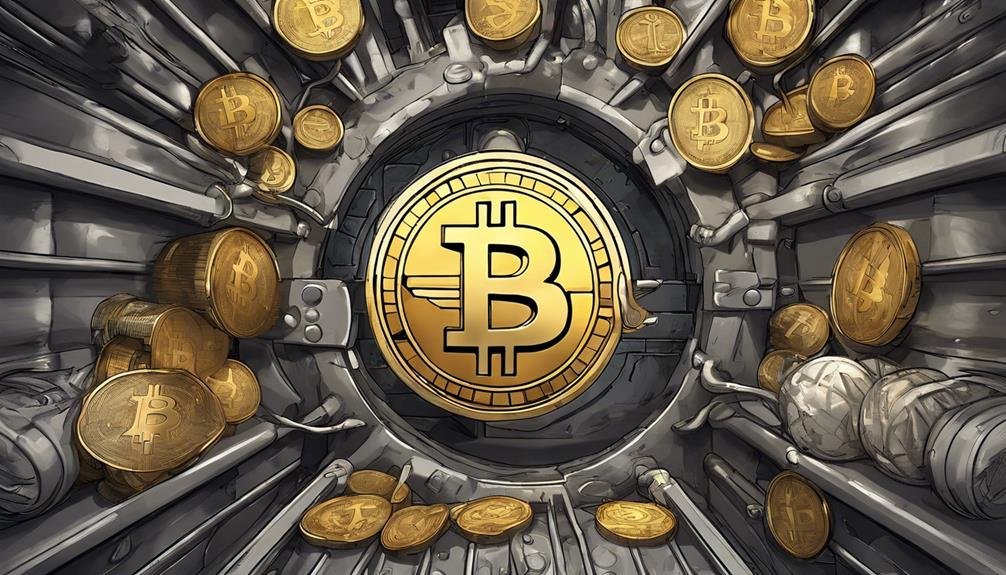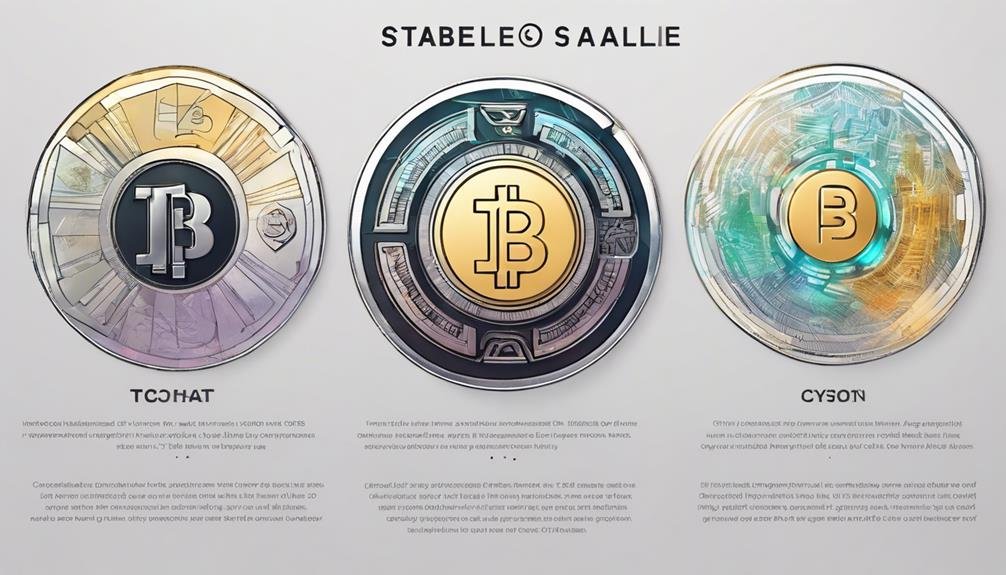Stablecoins are essential to the crypto market, with five critical types for beginners. Digital Dollar stablecoins like Tether and USDC are backed 1:1 by USD, ensuring stability and swift transactions. Fiat-collateralized stablecoins, such as USDT and USDC, are backed by fiat reserves and audited for transparency. Crypto-collateralized, exemplified by Dai, uses crypto assets for stability with over-collateralization. Algorithmic stablecoins rely on complex algorithms for supply control, adjusting based on demand. Commodity-backed stablecoins like Tether Gold are pegged to physical assets, providing price stability and exposure. Understanding these types is essential for maneuvering the crypto world effectively.
Brief Overview of 5 Types Of Stablecoins Explained For Beginners
- Digital Dollar Stablecoins: USDT and USDC offer stability, 1:1 USD backing, quick transfers, and market liquidity.
- Fiat-Collateralized Stablecoins: USDT, USDC, PAX backed by fiat, audited, and transparent.
- Crypto-Collateralized Stablecoins: DAI is backed by crypto assets and is decentralized and over-collateralized for security.
- Algorithmic Stablecoins: Use algorithms for supply regulation and dynamic adjustments based on demand.
- Commodity-Backed Stablecoins: XAUT is backed by commodities like gold, stable value, and diversification opportunities.
Digital Dollar Stablecoins
Digital dollar stablecoins, such as Tether (USDT) and USD Coin (USDC), are prominent in the cryptocurrency market due to their dependable 1:1 backing by the U.S. dollar, ensuring stability and facilitating seamless transactions. These stablecoins are a safe haven for investors looking to shield their holdings from the volatility often associated with other cryptocurrencies. The quick and efficient fund transfers enabled by USDT and USDC make them attractive for traders seeking to move capital swiftly within the digital asset space. Additionally, these stablecoins offer liquidity to the market, allowing for easy conversion to other cryptocurrencies or fiat currencies. This robust security and stability of digital dollar stablecoins provide a sense of reassurance to the crypto community.
USDC, in particular, has gained significant traction, with over $750 billion in transactions facilitated, underscoring its widespread acceptance and trustworthiness. The stable value of digital dollar stablecoins makes them a reliable medium of exchange for various transactions, contributing to their growing popularity within the cryptocurrency ecosystem. Trust in these stablecoins is further reinforced by their transparent reserves and adherence to regulatory standards, solidifying their position as key players in digital assets.
Fiat-Collateralized Stablecoins

Fiat-collateralized stablecoins, such as Tether (USDT), are secured by reserves of traditional fiat currencies like the U.S. dollar to maintain a stable value proposition in the cryptocurrency market. These stablecoins, like USD Coin (USDC) and Paxos Standard (PAX), are designed to be fully collateralized, guaranteeing a 1:1 ratio with the fiat currency they represent. One key aspect distinguishing fiat-collateralized stablecoins is their regular auditing process, which provides transparency and reassurance to users.
Independent audits and custody of reserves by trusted third parties help verify the authenticity of these stablecoins and maintain trust within the market. This rigorous auditing ensures that the stablecoins are backed by the equivalent fiat reserves, offering users a reliable means of storing and transacting value in the digital domain. Due to their stability and transparency, fiat-collateralized stablecoins have gained widespread acceptance. They are considered a pivotal component in the realm of digital assets.
Crypto-Collateralized Stablecoins

Moving from the domain of stablecoins collateralized by fiat currencies, the focus now shifts to a distinct category known as crypto-collateralized stablecoins. These stablecoins, such as Dai (DAI), are backed by cryptocurrencies like Ethereum assets rather than traditional fiat currencies like the USD. One key feature of crypto-collateralized stablecoins is over-collateralization, which guarantees stability and mitigates risks.
This means that the value of the collateralized assets supporting these stablecoins must exceed the stablecoin supply, providing a buffer against market fluctuations. By using cryptocurrencies as collateral, these stablecoins offer an alternative approach to maintaining stability compared to fiat-backed stablecoins. This method allows for decentralized control and transparency in the stablecoin ecosystem. Investors and users benefit from the security and reliability provided by blockchain technology while still enjoying the stability typically associated with fiat-backed stablecoins.
Algorithmic Stablecoins

Algorithmic stablecoins employ sophisticated algorithms to regulate their circulating supply and uphold their value, distinguishing them from traditional collateral-backed stablecoins. Here are some critical points about algorithmic stablecoins:
- Market Mechanisms: Algorithmic stablecoins like TerraUSD (UST) rely on market mechanisms and arbitrage opportunities to maintain their peg to a specific asset or currency.
- Supply Control: These stablecoins adjust their supply dynamically based on demand, aiming to balance the market and stabilize prices.
- Price Stabilization: The goal of algorithmic stablecoins is to stabilize the price by adjusting the circulating supply dynamically.
- Risk Management: However, recent events like the significant price drop experienced by UST on May 11, 2022, have highlighted the potential risks and challenges associated with algorithmic stablecoins. Credibility concerns may arise during market crises as algorithmic stablecoins may not have physical reserves like fiat-collateralized stablecoins.
Commodity-Backed Stablecoins

Have you ever considered the benefits of investing in stablecoins backed by physical commodities like gold, silver, or oil? Commodity-backed stablecoins derive their value from these physical commodities, such as gold reserves in the case of Tether Gold (XAUT). By being pegged to the price of the underlying commodity, these stablecoins offer price stability and a direct link to real-world assets.
Investors in commodity-backed stablecoins like XAUT gain exposure to gold, silver, or oil price movements, allowing for diversification and hedging strategies within the cryptocurrency market. This unique feature provides a level of security and reliability that may not be present in other types of stablecoins. For those looking to mitigate risks and explore alternative investment options, commodity-backed stablecoins can be a valuable addition to their portfolio, offering both stability and the potential for significant growth in a volatile market.
Frequently Asked Questions
What Are the 4 Types of Stablecoin?
The four main types of stablecoins are fiat-backed stablecoins, crypto-backed stablecoins, algorithmic stablecoins, and hybrid stablecoins. Each type offers unique features and mechanisms to maintain stability in the cryptocurrency market.
What Are Stablecoins for Dummies?
Stablecoins for dummies simplify the basics of stablecoin, emphasizing stability and dollar-pegged coins like USDT. Ideal for crypto beginners, they offer a buffer against price volatility, promoting the adoption of digital currencies while highlighting benefits and risks.
What Is the Easiest Crypto for Beginners?
For beginners, user-friendly stablecoins like Tether (USDT) or USD Coin (USDC) offer a simple entry point into the crypto market. These essential digital assets provide easy-to-understand value pegged to fiat currencies, making them ideal starter crypto coins. This accessibility and simplicity of stablecoins encourage newcomers to explore and participate in the crypto market.
What Are the Most Common Stablecoins?
Fiat-backed stablecoins, algorithmic stablecoins, decentralized stablecoins, centralized stablecoins, and collateralized stablecoins are common in the crypto market. These stablecoins aim to mitigate volatility, foster adoption, face regulatory scrutiny and pose risks and benefits.
Conclusion
To sum up, stablecoins come in various forms, each with unique characteristics and mechanisms. Digital Dollar, Fiat-Collateralized, Crypto-Collateralized, Algorithmic, and Commodity-Backed stablecoins serve different purposes in the cryptocurrency market. It is fascinating to see how these stablecoins maintain stability in a volatile digital world. Yet, their very existence challenges the idea of stability itself. The irony lies in that stablecoins introduce a new layer of complexity and uncertainty in attempting to create stability.










